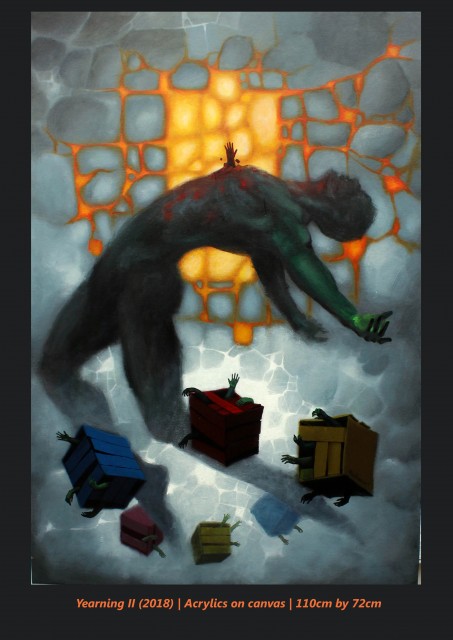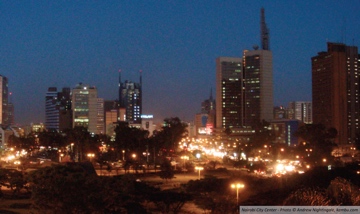Kenya's Young Artists
I was thrilled to meet and interview the three young artists who, in 2012, formed an artists’ collective called Brush Tu (Brush only). All three have gone on to make waves in the art world.

David Thuko
How did you become interested in art?
I was lucky enough to learn art in high school. I went on to do a Diploma in Fine Arts, specialising in drawing and painting, at Buru Buru Institute of Fine Arts. I realised I liked experimenting with different mediums. In college we studied classical artists like Picasso but I wanted to do something different.
What did you do after college?
I knew I didn’t want to be employed, but I had to do something to fund my canvases. I loved being part of the theatre, and when I met Boniface Maina, we started working at drama festivals doing backdrops and stage design. Then we were introduced to Michael Musyoka and together we found a small space. That space made us feel legitimate. We decided on a business name: Brush Tu. That was our unifying factor: we all used the brush.
Then what?
I’m a beneficiary of Langa Langa Scholarship Fund – that’s what got me through college. I do something with them every October, and in 2014 I gave them ten pieces – a proper exhibition. In 2015 I presented my first paper cuts – Paper Two – at Circle Art Agency. I exhibited under ArtLAB at International 154 in London, at AKAA – Also Known As Africa – in Paris, and at YIA – Young International Art Fair – in Paris. In 2017 I did my first show for The Attic. That was a site-specific exhibition: the idea was that there’s a certain way art is exhibited in a gallery but it’s not the same as the way art is hung in a house. It was experimental: work that would look right on a staircase or in a kitchen.
Tell me about your current work.
This is very much a story of myself. Starting in one place, crossing borders, engaging with new products, meeting new people: the process of doing that changes my identity to who I am now. So the idea isn’t simply consumerism, but that in acquiring items to consume you identify yourself with those items. You are what you eat – or what you consume. It’s an on-going process and the characters are in motion.
How did you create these pieces?
It’s physical but it represents a non-tangible idea. I used different layers, but I didn’t use a brush. I started by stretching the paper in water, cold press watercolour paper, and used the floor to keep it flat. I poured an over-diluted paint – a glaze – over the paper and let it settle and spread itself organically. The acrylic on paper picked up the texture of the tiled floor, and I used a sponge to scratch and peel it off to reveal different shapes, then added paper cuts on top. The observer is the last part of the piece. You become part of it when you see it. Once you consume something your identity becomes something else. The colours and symbols, and where I’ve put them, don’t always make sense: that challenges the observer and changes them.
See David Thuko’s exhibition BARCODE: The Layer Between at Red Hill Art: Gallery of Modern and Contemporary African Art www.redhillartgallery.com
Michael Musyoka
How did you become interested in art?
At school, we didn’t have art as a subject. They removed it from the syllabus just before I sat for my final exams in Primary School – I’d prepared for it, but they took it out. After school, I did a Diploma at Buru Buru Institute of Art where I specialised in art and design, drawing and painting.
What did you do after college?
I did a lot of commissions for murals in kids’ bedrooms. I got onto the Facebook page: Kilimani Mums’ Marketplace, and kept getting phone calls from women! I also worked as a waiter to help me clear bills from college. Then we started Brush Tu and things took off. I haven’t had a break since then.
Tell me about your art.
I’m a painter mostly, but I’ve done other things: collage, drawing. I don’t really like giving myself the title painter – I’m an artist. At the moment I’m doing a lot of paintings with acrylics on canvas, and I borrow a lot from fantasy art. I think my style is pivoting – it’s hinged on a style. I’m currently working on a series inspired by legislation – laws of the land – as well as morality and religion. I’m looking at law from the perspective of its being restricting. There are too many people in the world and it’s inevitable we create rules to organise ourselves. That’s a good thing but it’s also restrictive. Laws make us evolve into less of animals: we’re not really exploring our full animal capacities.
Is this for a show?
I’m doing a show called Yearning with Lincoln Mwangi, at The Attic. It’s about our experience of wanting more that what we restrain ourselves to. We’re yearning for more freedom. At the moment, we’re one of the most legislated people in Africa! There are so many rules you’re constantly at risk of committing a crime. When you’re naturally being yourself, you might be in contravention of the law. I’m constantly yearning to be free. Although I’m not in prison, I’m only free as long as I work within the confines of the law. I’m exploring the subject more, reading around it. Look at the Nairobi bylaws – no one can live by them. They make everyone a criminal. Now they’re talking about licences to showcase art. You need a licence to exhibit art!
See Michael Musyoka and Lincoln Mwangi’s exhibition YEARNING at The Attic Art Spacehttps://www.facebook.com/theAtticartspace/
Boniface Maina
How did you become interested in art?
I come from a town without much art – certainly no contemporary art, only curios and art for tourists. I was introduced to them when I was little. I had an artistic mind, but it was an unconscious thing. My first painting was a watercolour and it was ridiculous: I didn’t know how it worked. I painted in acrylic style on cartridge paper, so the piece cracked because the layer was over-applied. Then I made kitsch wildlife art. I was trying to achieve what I saw, but I was copying from a guy who painted very thickly. But those experiences helped me in life – they prepared me for selling paintings to people, and for how to deal with rejection!
What did you do after that?
I went to the YMCA National Training Institute pursuing art and design. I learned to use what I have around me. I want to paint on canvas, but if I can’t afford it, I have to use something else. I really need to paint. If I have to stretch the bed sheet or the curtains, then that’s what I have to do. I used to scribble on the walls. My mother will be very happy I’m now using pen and acrylic on canvas.
Tell me about your art.
I’m an experimental artist. It’s hard for me to box myself into any particular style or subject. I’m curious about material, space, lighting, colour. Sometimes art is self-conscious and you need to get it out. I find myself picking something from my old work and bringing it to my new work. I’m also curious about the conversation between artists, and between the artist and the viewer. It’s a journey. Sometimes artists are very different from their work. You look at their work and you can’t see them in it at all. I go to art shows and I see contradictory work from what I believe in, and I wonder – why are you painting the canvas like this? Don’t abuse the canvas. I’m learning from my peers, from other people’s works and from the materials they use. I try to get into the artist’s mind.
What’s your current project?
I’m doing sketches for a series called Burdens of Being. It’s a study of links: why certain things link, and why someone would choose that specific space for that specific thing. I’m using loo paper holders. It’s amazing how long you spend sitting on the loo. That’s when I’m looking at the walls, thinking about things, distracting myself, getting ideas – and I thought: why not use this as a process. It’s an inquisitive way of trying to learn about the process of art. That small tissue paper holder represents the entire process of my art.
Tamara Britten, 25 August 2020
Published also in: The Link: Safarilink's inflight magazine
About the region
Nairobi

Nairobi is a thriving, cosmopolitan hub of government offices, embassies, businesses, banks, churches, mosques, temples, shops, restaurants and markets. Attractions include the National Museum, Railway Museum, National Archives, Karen Blixen Museum and Bomas of Kenya. Nairobi is the world’s only capital city to boast a national park within its boundaries.
Read more about Nairobi